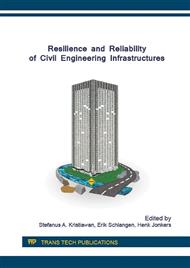p.100
p.106
p.113
p.119
p.126
p.132
p.140
p.148
p.154
Performance of Reactive Powder Concrete Partial Prestressed Beam-Column Sub-Assemblage Structure System with Partial Prestressed Ratio Exceeds 30%
Abstract:
Research on concrete material in many countries resulted a concrete type of Ultra High Performance Concrete (UHPC) which has a high performance in terms of compressive strength, ductility, durability, and modulus of elasticity using Reactive Powder Concrete (RPC). Research on structural engineering using RPC material shows better performance than normal concrete (NC) to resist gravity and cyclic loads. In this study, the experiments were conducted under the combination of constant axial and cyclic loads on the structure of the partial prestressed interior and exterior beam-column subassemblages with partial prestressed ratio value of 31.72% on the beam. The application of cyclic loading was conducted by displacement control based on the ACI 374.1-05. The purpose of this study was to determine the performance of structures based on three moment frame acceptance criteria presented in the ACI 374.1-05. From the test results, the interior and exterior beam-column subassemblage structure systems showed performance that adequated all of these criteria at the drift ratio of 3.50% and 2.20%, respectively.
Info:
Periodical:
Pages:
126-131
Citation:
Online since:
July 2016
Price:
Сopyright:
© 2016 Trans Tech Publications Ltd. All Rights Reserved
Share:
Citation:


